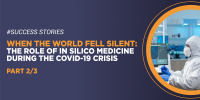In this second article of our series on in silico medicine during the COVID-19 response, we explore how computer models helped optimise vaccine doses, test therapies, as well as simulate immune responses, virtually—saving time, reducing risk, and guiding smarter, faster decisions in a race against the clock.

If you missed the first part of the series, you can read it here.
On December 2nd, 2020, the world took a collective breath. Pfizer and BioNTech had just announced that their mRNA-based vaccine, BNT162b2, received emergency use authorisation in the UK, making it the first approved vaccine against COVID-19. Less than a year after the first reports of a mysterious virus emerged from Wuhan, we had a vaccine that empowered our immune system to respond to the pandemic. A new chapter had begun, one defined by resilience and innovation.
But how did we get there so fast?
Before 2019, coronaviruses weren’t considered particularly threatening. Of the strains known to infect humans, most caused only mild symptoms– nothing worse than the common cold. In the recent past, only two had raised alarms: SARS in 2002 and MERS in 2012. But both outbreaks had been relatively contained, with just a few thousand cases worldwide. With such a low perceived risk, research into coronavirus vaccines was limited, slow, and underfunded.
Then came COVID-19. Global spread. Overflowing hospitals. Lockdowns. The crisis demanded a quick response, even though vaccine development is typically anything but fast, or cheap. Designing, testing, and approving a vaccine can take more than a decade and cost billions. Even the development of the Ebola vaccine in 2019, considered record-breaking at the time, took over 15 years from lab to clinic.
In this context, a new ally emerged: in silico medicine. The use of computer models to simulate biological processes and predict outcomes allowed researchers to move fast while also not placing lives at risk. Thus, saving precious time and limiting harms and failures.
One of the earliest examples came from Tezpur University and the University of Hyderabad in India. Scientists Arpita Devi and N. S. N. Chaitanya used neural networks and machine learning to design a vaccine against all known coronaviruses. Like much of the global scientific community, they focused on the virus’s spike protein, the molecular lockpick SARS-CoV-2 uses to enter human cells.
By analysing the various spike proteins of all known human coronaviruses, they identified 18 segments most likely to trigger an immune response, while also being non-toxic and non-allergenic. These segments were combined to design a virtual vaccine to be tested on computers.
Next, they turned to computational modelling to simulate the vaccine’s 3D structure and predict key physical properties—such as stability and half-life—crucial for large-scale production, storage, and distribution. Their models also forecasted the immune response across multiple doses. The results were encouraging: the first dose produced a modest reaction, while the second and third triggered a strong, sustained immune response—the kind typically seen in effective vaccines.
Ultimately, the first vaccines to reach the market used a different platform: mRNA. Yet, the approach used by Devi and Chaithanya proved highly effective, and similar in silico methods are now being applied to the development of vaccines for monkeypox, cytomegalovirus, cervical cancer, and beyond.
Meanwhile, in Catania, Italy, Prof. Francesco Pappalardo and his team weren’t focused on designing vaccines, but on testing them. Employing their Universal Immune System Simulator (UISS) platform, they modelled how the immune system would react to a promising antibody candidate known as 47D11. This antibody targets the spike protein of both SARS-CoV and SARS-CoV-2, thereby blocking them from infecting human cells.
Their computer simulations explored two possible ways to use the 47D11 antibody. First, as a possible early substitute to vaccine: the model predicted that 47D11 could provide protection against infection for up to three months, but its effectiveness would start to wane after that. In silico studies further identified that a booster dose might be needed by month four, in order to extend the protection up to one year. Second, as a therapeutic: they simulated what would happen if the antibody was administered immediately after exposure to the virus. The results were clear, early intervention was key. When given within the first day, the treatment was effective; from the second day, its impact dropped dramatically.
These insights offered valuable guidance for clinical trials and real-world treatment strategies, helping researchers and healthcare professionals make better decisions, faster.
Such efforts from researchers in academia and industry contributed to a record-breaking rollout of dozens of vaccines around the world. But as vaccines became available, a new challenge emerged: How do we ensure a broad and equitable global coverage with limited supply?
An international team led by Prof. Vittorio Cristini—uniting scientists from the U.S., Mexico, and Italy—set out to answer that question. Using a data-driven mathematical model grounded in physiology, immunology, and biophysics, they optimised vaccine dosing schedules to extend the interval between doses without compromising efficacy. The goal: maximise population coverage while using as few doses as possible.
This strategy was designed to reduce global inequalities in vaccine access—supporting countries with limited infrastructure and supply chains, lowering costs, and improving public compliance. Notably, the model revealed that immunocompromised individuals required longer intervals between doses—25 to 30 days—to develop sufficient immunity. In contrast, healthy individuals could safely wait around two and a half weeks, and in some cases up to six weeks, without reducing protection.
At the height of the pandemic, when vaccines were scarce and demand was overwhelming, computer models like this allowed for smarter, more efficient decisions that quite literally saved lives.
In the end, in silico medicine didn’t just accelerate vaccine development. It transformed how we respond to global health crises, allowing us to test faster, plan smarter, and take steps towards the end of the pandemic. One simulation at a time.
References: